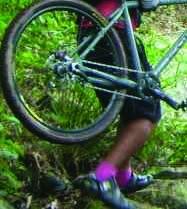Post by vic on Jul 4, 2006 14:13:11 GMT 8
and this... 

Hill Climbing for Better Cycling and Triathlons
BECOME KING OF THE HILL
TECHNIQUE AND PRACTICE TIPS
How do you feel when you're cycling along and come upon a hill so steep and long that it appears endless? Do you dread it? Do you have the urge to turn around? Do you plan your routes to avoid hills? Fear no more. Hill climbing is quite manageable - it can even be enjoyable - once you grasp the basic principles. Climbing hills is a skill upon which everyone can improve. Hill climbers must know when to shift, when to come out of the saddle and when to push hard. Several variables come into play; every rider must find out what works best for them. Understand the ideas and concepts, of successful hill climbing, then adapt them to fit your individual style.
PLANNING YOUR PACE
1) Ride a little easier on the flats, especially on the downhills in anticipation of an ascent; do not lose speed at the start of the uphill. Practice this technique to adapt your body to a slightly changing pace. The goal is to avoid being penalized for pushing harder, and to recover quickly when cycling easier.
2) Work at least 10% harder on the uphills, especially near the top, where you slow down and aerodynamics are less important. All your effort goes into getting you up the hill rather than into fighting the wind, whereas in the downhill, all your energy goes into fighting the wind. In order to go just a little faster, you must pedal a lot harder. In addition, riding just a little faster will gain you minimal time, because you are already going fast (i.e. increasing speed from 14 mph to 15 mph is more significant than going 33 mph to 34 mph). You should still pedal through the downers, but also try to rest, drink and maintain aerodynamics. If you are going at least 36 MPH, tuck your knees in and coast since pedalling makes you less aerodynamic.
3) Anticipate shifting and do it before you really must, as this will save your legs and allow the gears to shift smoothly.
TECHNIQUE AND PRACTICE TIPS
Use a combination of sitting and standing for tackling longer, steeper hills. This rule does not apply to cyclists who are going fast enough that aerodynamic drag is still significant, or for those who are inefficient at standing. Remember on steeper hills, once you come out of the saddle, there is no going back. Make sure you are in the right gear. Practice coming out of the saddle smoothly so you don't lose speed. When your cadence drops to around 65-75 RPM come out of the saddle when one leg is at the top of the pedal stroke. Here your power is negligible, so it's a good time to either shift gears or change climbing positions. If you practice your transition from sitting to standing, and from standing to sitting, you will be able to change your position on longer hills and use different muscle groups. While seeking to become a successful hill climber focus on improving your technique rather than on exhausting yourself on hill repeats.
When standing, rock the bike gently from side to side in a rhythmic fashion. Your primary power in cycling out of the saddle is generated at the three-o'clock position, however many riders continue to drive downward through the six-o'clock position of their stroke, driving their energy into the road instead of driving the bike up the hill. Ankle movement will help improve your rhythm. When standing, balance your weight slightly in front of the crank center and relax your upper body as the bike rocks back and forth. Be smooth and graceful. An advanced standing technique is to throw your knees at the handlebars, which gains extra power on the upstroke and lets your weight take care of the downstroke. This can be practiced once you have developed a smooth climbing rhythm. Practice standing techniques on the flats or gradual hills. During races it may be fastest to stand for 30 seconds, or maybe for one minute. To prepare, it would be wise to practice standing for up to three minutes. Don't swing the front wheel off-center when climbing out of the saddle. Weaving up the road scrubs off speed and wastes energy. Ride straight!
Practice hill climbing techniques often. Go hard occasionally, but focus on proper form and rhythm. Let's face it: when you conquer hills, the flats and downhills become routine. In time, you will look forward to taking the hilly routes and your friends will ask you to slow down on the hills.
SARK PRODUCT HILL CLIMBING TIPS
1) Be efficient on the flats and downers, maintaining good momentum going into the hill .
2) Anticipate shifting and do it before you must.
3) In the steeps, once you're out of the saddle there is no going back.
4) Come out of the saddle when one leg is at the top of the pedal stroke.
5) Balance your weight slightly in front of the crank center.
6) Push through the 3 o'clock Position and use ankle movement to prevent wasting energy in the 6 o'clock position.
7) Rock bike gently from side to side keeping the front wheel centered.
8) Focus on smooth technique and rhythm
9) Work at least 10% harder on the hills especially near the top
Jamie Sarkisian is the manufacturer of Sarkbar aerodynamic handlebars and has also written a Computer Program that simulates bike riding over real courses and lets the user experiment with different variables that have been applied to practical riding situations.


Hill Climbing for Better Cycling and Triathlons
BECOME KING OF THE HILL
TECHNIQUE AND PRACTICE TIPS
How do you feel when you're cycling along and come upon a hill so steep and long that it appears endless? Do you dread it? Do you have the urge to turn around? Do you plan your routes to avoid hills? Fear no more. Hill climbing is quite manageable - it can even be enjoyable - once you grasp the basic principles. Climbing hills is a skill upon which everyone can improve. Hill climbers must know when to shift, when to come out of the saddle and when to push hard. Several variables come into play; every rider must find out what works best for them. Understand the ideas and concepts, of successful hill climbing, then adapt them to fit your individual style.
PLANNING YOUR PACE
1) Ride a little easier on the flats, especially on the downhills in anticipation of an ascent; do not lose speed at the start of the uphill. Practice this technique to adapt your body to a slightly changing pace. The goal is to avoid being penalized for pushing harder, and to recover quickly when cycling easier.
2) Work at least 10% harder on the uphills, especially near the top, where you slow down and aerodynamics are less important. All your effort goes into getting you up the hill rather than into fighting the wind, whereas in the downhill, all your energy goes into fighting the wind. In order to go just a little faster, you must pedal a lot harder. In addition, riding just a little faster will gain you minimal time, because you are already going fast (i.e. increasing speed from 14 mph to 15 mph is more significant than going 33 mph to 34 mph). You should still pedal through the downers, but also try to rest, drink and maintain aerodynamics. If you are going at least 36 MPH, tuck your knees in and coast since pedalling makes you less aerodynamic.
3) Anticipate shifting and do it before you really must, as this will save your legs and allow the gears to shift smoothly.
TECHNIQUE AND PRACTICE TIPS
Use a combination of sitting and standing for tackling longer, steeper hills. This rule does not apply to cyclists who are going fast enough that aerodynamic drag is still significant, or for those who are inefficient at standing. Remember on steeper hills, once you come out of the saddle, there is no going back. Make sure you are in the right gear. Practice coming out of the saddle smoothly so you don't lose speed. When your cadence drops to around 65-75 RPM come out of the saddle when one leg is at the top of the pedal stroke. Here your power is negligible, so it's a good time to either shift gears or change climbing positions. If you practice your transition from sitting to standing, and from standing to sitting, you will be able to change your position on longer hills and use different muscle groups. While seeking to become a successful hill climber focus on improving your technique rather than on exhausting yourself on hill repeats.
When standing, rock the bike gently from side to side in a rhythmic fashion. Your primary power in cycling out of the saddle is generated at the three-o'clock position, however many riders continue to drive downward through the six-o'clock position of their stroke, driving their energy into the road instead of driving the bike up the hill. Ankle movement will help improve your rhythm. When standing, balance your weight slightly in front of the crank center and relax your upper body as the bike rocks back and forth. Be smooth and graceful. An advanced standing technique is to throw your knees at the handlebars, which gains extra power on the upstroke and lets your weight take care of the downstroke. This can be practiced once you have developed a smooth climbing rhythm. Practice standing techniques on the flats or gradual hills. During races it may be fastest to stand for 30 seconds, or maybe for one minute. To prepare, it would be wise to practice standing for up to three minutes. Don't swing the front wheel off-center when climbing out of the saddle. Weaving up the road scrubs off speed and wastes energy. Ride straight!
Practice hill climbing techniques often. Go hard occasionally, but focus on proper form and rhythm. Let's face it: when you conquer hills, the flats and downhills become routine. In time, you will look forward to taking the hilly routes and your friends will ask you to slow down on the hills.
SARK PRODUCT HILL CLIMBING TIPS
1) Be efficient on the flats and downers, maintaining good momentum going into the hill .
2) Anticipate shifting and do it before you must.
3) In the steeps, once you're out of the saddle there is no going back.
4) Come out of the saddle when one leg is at the top of the pedal stroke.
5) Balance your weight slightly in front of the crank center.
6) Push through the 3 o'clock Position and use ankle movement to prevent wasting energy in the 6 o'clock position.
7) Rock bike gently from side to side keeping the front wheel centered.
8) Focus on smooth technique and rhythm
9) Work at least 10% harder on the hills especially near the top
Jamie Sarkisian is the manufacturer of Sarkbar aerodynamic handlebars and has also written a Computer Program that simulates bike riding over real courses and lets the user experiment with different variables that have been applied to practical riding situations.








 .
.
 next would be "the wall"
next would be "the wall" 








